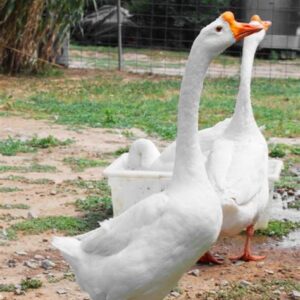Description
Toulouse are good foragers and can withstand cold winters and hot summers. The Toulouse goose is a solid egg layer, and their easy-going behavior makes them great pets. The Toulouse goose is also an exhibition bird.
The name Toulouse is used for several types of gray geese descended from the European Greylag. People have selected Toulouse as general-purpose farm birds, as producers of fois gras, and as show-birds. Oscar Grow, in his 1963 article “The Toulouse Goose,” discusses how trying to include both aesthetic and practical traits under the name of one breed is problematic. For this reason, The Livestock Conservancy recognizes one breed, the “Toulouse,” and two types: Production and Dewlap. People have bred the more numerous Production type as utility birds for small farms and homesteads. The Dewlap Toulouse is a massively boned bird bred for its ability to rapidly gain weight and produce fois gras. A subset of these birds bred for exhibition may show an exaggerated dewlap and keel.
The importance of feeding all growing creatures The ‘Toulouse’ in France, although kept in greater numbers, have never quite equaled such weights. The Toulouse Goose is one of the larger goose breeds. In its exhibition or “dewlap” form, the Toulouse Goose may have its body skimming the ground. The “utility” Toulouse Goose is smaller and lacks the dewlap being basically a cross bred grey Heinz with no value other than for the table.
Country of Origin: France . The Toulouse Goose was bred in southern France (near the city of Toulouse) originally for pate de Fois Gras now considered a superior meat bird in Europe. The breeding work to finalize the points and breed true was done in England with a great number being exported to America and Canada prior to the 1950’s . At the moment the Club has been importing a number back from the USA as the gene pool in Britain has become too narrow making a number of males virtually infertile.
Breed Background: A heavy breed which does well in confinement since their size restricts foraging and although their goslings tend to grow slower than other geese. The progeny of a Toulouse goose crossed withan Emden gander grow rapidly.. and is the basis for commercial breeds.
Names Also known as L’oie Grise des Landes and L’oie du Toulouse in France/Belgium the name alteration appears to be area
Country Of Origin;……..France
Carriage; like a galleon in full sail or Margaret Rutherford in feathers for the older reader
Purpose;………Eggs..Meat…Broody…exhibition
Egg Colour.………………..white
Egg Numbers…………..Lowest is average about 35 per season also known 60+ per Goose.Not always fertile from young due to anatomy ! . If a good strain then the average Toulouse lays 220-240 eggs per year the best layer so ask the seller whether a laying or decorative strain !
Broodiness: Incubation:. . . . 28 – 34 days/ good mother but clumsy due to size need a large hay covered tray for the eggs to prevent crushingas they pip. Otherwise hatch very well under Muscovies.
Breed Hints….Kept as trio or pair .. will go broody and hatch
Weights; Gander, 12 kg / 26 poundsGoose, 9 kg / 20 pounds
Breed Tip**As a breed succeptible to flystrike (maggots) on open cuts or scratches which are disguised by the open feathering.
tip Due to their size in comparison to their leg length they prefer real ponds or shallow edged trays/ childrens sandpits (ELC or IKEA) as many others can produce a snug fit. Wickes builders merchants do a’cement mixing tray’ in black composite. . . cheap!
Appearance: Grey feathers laced with white, brown eyes with a long deep body with a prominent breast bone. Better show birds have apronounced front as in the picture and double muscled folds when seen from the front. Better breeding birds often have less front or their’equipment’ does not reach to mate successfully
Meat Production: The supreme meat crosswhich tends to pass on the placid (dumb) temperamernt to the off spring. As a pure breed it often resembles a large tub of lard withfeet …..so unless a very poor specimen not worth the plucking…… better for the breeding pen for X breds.




Reviews
There are no reviews yet.